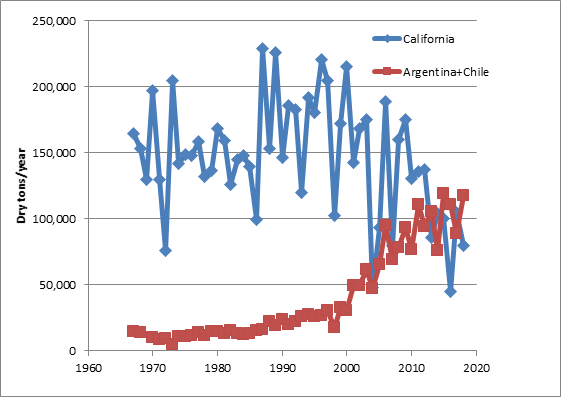Bigger crops often follow small to medium crops. [The 2018 prune crop looks to be 25-30% off the 2017 crop.] California should expect a larger prune crop in 2019 compared to 2018, weather allowing. While nobody can be certain what the crop will be in ’19, given past history and world production trends, it’s not too early to review production management practices prune growers could use to maximize their income/acre in 2019.
Bigger crops generally mean smaller fruit, unless growers manage their cropload, which means thinning with or without pruning. Smaller fruit have less value than large dried fruit and cost more to harvest and dry.
California growers who grow large crops of small fruit in 2019 should have strong competition in international markets from other, lower cost/price producers. Why is that? California produced 30% less of the world’s prune crop in 2017 than in 1997, while the total volume in the world market only dropped 12% in those years. The difference in production has largely been made up by South America (Chile and Argentina). See the change in production over time between California and South America in Figure 1, with data from the International Prune Association 2018 International Congress presentations. [Good news going forward is that plantings in South America have slowed dramatically (see recent IPA data).]

Growers in Chile and Argentina average 70-75 ct/pound dry fruit sizes and their costs are lower than those for California growers. Also, in general, prices of prunes from South American are significantly less than for prunes grown in California (see Stock Management presentation from 2018 IPA congress for an example of price differences between producing countries). Finally, major emerging markets that used to consume significant tonnage of small fruit (China, Brazil, and Russia) have dramatically reduced their use of prunes since 2014. The world supply of small fruit is up (more production, less overall consumption) and that generally means lower prices for those categories.
To deliver the best possible returns this year, growers may want to consider focusing on producing large – A & B — screen fruit. How? Manage cropload (prune and thin) and avoid early (immature fruit) harvest. Thinning is less expensive than pruning and can be done every year (if needed). Do what you can to harvest when the fruit is mature, not before. Fruit harvested before the fruit reaches maturity (3-4 lbs internal pressure) contains less sugar and dries to a smaller fruit size compared to mature fruit. Consider all possible options to get fruit harvested on time, but not before.
Prune buds are not pushing, yet, but now is the time to think about the coming season before the days get filled with doing. Talk with your neighbors and packers to put together a plan for the coming season. Consider attending the local UCCE prune grower meetings (see dates and agendas in this newsletter). Prunes, farmed with the goal of good production of large fruit, should be an important and valuable crop to support diversified growers and the region’s economy in 2019.


Leave a Reply